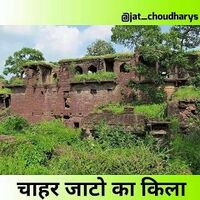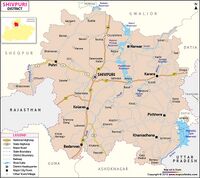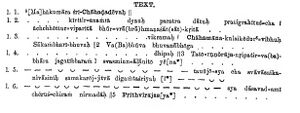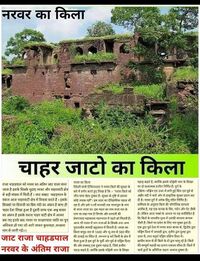Narwar Shivpuri
| Author:Laxman Burdak, IFS (Retd.) |


Narwar is a village in Narwar tahsil of district Shivpuri, Madhya Pradesh.
Variants of name
- Nalapura (नलपुर) = Narvar (नरवर) (AS, p.481)[1]
- Naravara (नरवर) (AS, p.479)
- Naravara (नरवर) = Navanagara (नवनगर)(AS, p.483)
Location
Origin
Nala (नल) was a Suryavanshi Kachhawah Jat who founded Narwar and made his capital. He defeated and killed Ghumasura who had defeated even Indra. [2]
According to James Tod [3]Some of Kusha's immediate offspring, Raja Nal founded the kingdom and city of Narwar in S. 351, or A.D. 295
History
According to James Tod [4]The Kushwaha race claims descent from Kusha, the second son of Rama, King of Koshala, whose capital was Ayodhya. Some of his immediate offspring, is said to have migrated from the parental abode, and erected the celebrated castle of Rhotas, or Rohatas on the Soan, whence, in the lapse of several generations, another distinguished scion, Raja Nal, migrated westward, and in S. 351, or A.D. 295, founded the kingdom and city of Narwar, or classically, Nishada.3 Some of the traditional chronicles record intermediate places of domicile prior to the erection of this famed city : first, the town of Lahar, in the heart of a tract yet named Kushwagar, or region (gar) of the Kushwahas ; and secondly, that of Gwalior. Be this as it may, the descendants of Raja Nal adopted the affix of Pal until Sora Sing (thirty-third in descent from Nal), whose son, Dhola Rae, was expelled the paternal abode, and in S. 1023, A.D. 967, laid the foundation of the state of Dhoondar in Jaipur region.
Raja Chahar Deo ruled at the Narwar fort in Gwalior region at the end of 13th century. Coins of Chahar Deo are found in the region with "Asawar Sri Samant Deo" marked on one side and "King riding horse" on the other side. Raja Chahar Deo ruled Narwar till vikram samwat 1355. After the fall of his rule at Narwar his descendents moved to "Brij Bhumi" region of Uttar Pradesh. Other group of Chahar Jats moved to Matsya and Jangladesh regions of Rajasthan.
History of Chahadadeva
No. 26 Rataul Plate of Chahadadeva[5] mentions....[p.223]: We see from what has been said above that the surviving portion of the inscription supplies no clue as to the place of Chahadadeva in the Chahamana pedigree. Nor do the Sanskrit poems referred to in the preceding paragraph mention his name. It is true that in the genealogical tree of the Chahamana tribe published by Tod, Chahadadeva (spelt Chahirdeo) is shown as the younger brother of Prithviraja. But as Tod’s account of the Chahamanas is based on the Prithviraja Rasa which has been proved to be a forgery,3 we cannot accept this information as correct unless it is supported by some more reliable source. For the present, the question must remain an open one. There is one thing, however, about this prince which seems to be fairly certain, namely, that he is in all probability the same as the ruler of that name who flourished at Narwar (ancient Nalapura) in Gwalior State in the first half of the 13th century A.D. We shall examine the evidence in the following paragraphs.
General Cunningham has shown from an inscription discovered by him in the ancient fort of Narwar that the rulers of that place included a line of five chiefs the last of whom, Ganapati, was reigning in 1298 A.D. (Vikrama Samvat 1355).4
The genealogy of this family opens with Chahadadeva, whose coins bear dates Vikrama Samvat 1295 to 1311 (A.D. 1255).5 There is, however, an earlier ruler named Malayavarmadeva whose name figures in numismatic works under the Narwar family. His coins bear dates Samvat 1280, 1283 and 1290 and have been found at Narwar, Gwalior and Jhansi. General Cunningham was of opinion that Malayavarmadeva was a ruler of Narwar but that he belonged to a different dynasty and was ejected from Narwar by Chahadadeva who 'was consequently the founder of the above mentioned family of Narwar.6
Now, as the Chahamana Chahadadeva of the inscription under review flourished just about this time, if we are to judge from the type of characters used in it, I am inclined to think that the founder of the Narwar family was no other than his namesake of the Chahamana tribe. When precisely Chahadadeva or his family migrated to Narwar, cannot yet be determined. It may have happened after the downfall of Prithviraja when his followers escaped from Delhi and Ajmer in large numbers. The Muhammadan historians tell us very little about this period. But we learn from the Hammira-Mahakavya that not long after the defeat of Prithviraja the Chahamanas were turned out of Ajmer, when they retired to Ranathambhor, which continued in their possession until Hammira-deva was slain and the town captured by Alau-ddin in 1299 A.D.7 It is surprising that the Hammira-Mahakavya, as it exists,8 does not
1 Elliott, History of India, Vol. II, p. 216. According to Tod (Rajasthan, II, p. 451) Prithviraja had a son by name Rainsi who was slain in the battle with Shahabu-d-din.
2 Ind. Ant., Vol. VIII, pp. 61-62. Rajasthan, II, p. 451.
3 Journal of Beng. As. Soc., Vol. LV, Part I, pp. 5 ff.
4 Archeological Survey of India, Reports, Vol. II, p. 315, and Ind. Ant., Vol. XXII, p. 81.
5 Cunningham, Coins of Medieval India, pp. 92-93 and PI. X.
6 Later, Cunningham changed his opinion and declared that Malaya may have belonged to the same family. The latter view seems to me to be unlikely.
7 This last event is narrated by Muhammadan historians in detail. Cf. Tarikh-i-Firoz Shahi in Elliott History of India, Vol. III, pp. 171-179. ’ 8 Mr. Kirtane made his analysis from a copy which is dated in Vikrama Samvat 1542, ie., 186 years after the death of Hammira.
[p.224]: mention the name of Chahadadeva among the chiefs of Ranathambhor. This, however, is not a serious objection. For we learn from a Muhammadan historian, named Maulana Minhaju-ddin, that in A.H. 632 (A.D. 1234) Shamsu-d-din Altamsh defeated at Ranathambhor a powerful ruler of the name of Chahadadeva who sustained another defeat in A. H. 649 (A.D. 1251) near Narwar at the hands of Ulugh Khan, the Commander of the forces of Balban.1 This account must be correct, for Minhaju-d-din informs us that he heard of Chahadadeva’s bravery at the battle of Ranathambhor from the mouth of Nusratu-d-din Ta-yas‘ai himself who led Altamash’s forces on this occasion.2 We may, therefore, conclude that Chahadadeva held sway over both Ranathambhor and Narwar where, indeed, he is said to have been born.3 This need not surprise us for we learn from the Delhi-Siwalik pillar inscription that at one time the Chahamanas ruled over the entire territory between the Himalayas and the Vindhyas. It also follows from what has been said above that Chahadadeva must have flourished just mid-way between the fall of Prithviraja and that of Hammira.

Another argument in favour of the identification of the Chahamana Chahadadeva of our inscription and the Chahadadeva of Narwar is afforded by numismatic records. The coins of Chahadadeva discovered at Narwar, etc. are of two kinds, namely those issued by him as an independent ruler and secondly those struck by him as a tributary to Altamsh. The coins of both these kinds are of the bull and horseman type like those of the Chahamana rulers and, what is more, those of the first kind also hear on the reverse the legend of Asavari-sri-Samantadeva4 which only occurs on the coins of the Chahamana Somesvara and his son Prithviraja.
It will be observed that in the inscription, Chahadadeva is called a Mahakumara or chief heir-apparent. The grant must consequently have been issued by him before his enthronement.
1 Cunningham (Coins of Medieval India, pp. 90-91) and Thomas (Pathans of Delhi, p. 67) maintained that one and the same Hindu chief was defeated at Ranathambhor and Narwar. According to Cunningham Major Raverty held that two different rulers were intended. This view is refuted by Major Raverty’s own translation of the Tabakat-i-Nasiri (p. 824) where both the defeats are clearly attributed to the same person.
2 Tabakat-i-Nasiri translated by Raverty, p. 825.
3 Ind. Ant, Vol. XXII, p. 81.
4 This legend is evidently developed from that of Sri-Samantadeva on the Tomara coins, which is perfectly natural, for the Chahamanas were the immediate successors of the Tomaras at Delhi. (See Palam Baoli inscription in Journal Beng. As. Soc., Vol. XLI1I, Part I, Pi. X.) inscription
5 A part of the top stroke of ma is extant. 6 Read - Kemdurs.
नरवर
विजयेन्द्र कुमार माथुर[6] ने लिखा है....1. नरवर (AS, p.479) = नलपुर: मध्य प्रदेश राज्य के शिवपुरी जिले में ग्वालियर के समीप सिंध नदी के ठीक पूर्व में स्थित है। यहाँ स्थित क़िला, जो विंध्य पर्वतश्रेणी की एक खड़ी चट्टान पर स्थित है, मध्यकालीन भारतीय इतिहास में महत्त्वपूर्ण स्थान रखता था। महाभारत में वर्णित नलोपाख्यान (वनपर्व) के नायक राजा नल की राजधानी नलपुर या नरवर में थी. 'नलपुर' नाम का उल्लेख 12वीं शताब्दी तक के संस्कृत अभिलेखों में है. यहाँ का पहाड़ी किला सर्वप्रथम कछवाहा -राजपूतों के अधिकार में था. इसके पश्चात 15वीं शती में नारपुर मानसिंह तोमर (1486-1516 ई.) केयधिकार में रहा. मानसिंह और मृगनयनी की प्रसिद्ध प्रेम कथा से नरवर का सम्बन्ध बताया जाता है। कहते हैं कि नरपुर के विषय में स्थानीय रूप से प्रसिद्ध कहावत 'नरपुर चढ़े न बेड़नी बूंदी छपे न छींट, गुदनोटा भोजन नहीं एरछ पके न ईंट,'--लगभग इसी समय प्रचलित हुई थी.
राजस्थान की प्रसिद्ध प्रेम कथा ढोला-मारु का नायक ढोला, नरवर नरेश का पुत्र बताया गया है। मारू या मरवण पूंगलगढ़ की राजकुमारी थी. नरवर परवर्ती काल में मालवा के सुल्तानों के कब्जे में रहा और 18वीं शताब्दी में मराठों के आधिपत्य में चला गया। 19वीं शताब्दी के आरंभ में मराठा सरदार सिंधिया ने इसे जीत लिया। परकोटे से घिरे इस नगर के बाहर तोमर सरदारों के स्मारक स्तंभ खड़े हैं। सिंधिया के समय के भी कुछ स्मारक, हवापोर, एकखम्बाछतरी आदि यहा स्थित हैं.
2. नरवर (AS, p.479) = नरवर अलीगढ़, उत्तर प्रदेश में गंगा नदी के तट पर स्थित राजघाट से 3 मील (लगभग 4.8 कि.मी.) दूर स्थित है। यहाँ प्रचलित जनश्रुति है कि महाराज नल की इसी स्थान पर राजधानी थी। नरवर के निकटवर्ती प्रदेश को 'नल क्षेत्र' कहा जाता है। (दे.नरवर)
नरेसर - नलेसर - नरराष्ट्र - नलराष्ट्र
विजयेन्द्र कुमार माथुर[7] ने लिखा है....नलेसर (AS, p.482): नरेसर अथवा 'नलेसर' ग्वालियर, मध्य प्रदेश का एक ऐतिहासिक ग्राम था। ग्वालियर के दुर्ग से प्राय: 10 मील की दूरी पर उत्तर-पूर्व वनप्रांत के अंतर्गत नरेसर ग्राम के खंडहर उपस्थित हैं। 11वीं-12वीं शतियों के मंदिरों तथा मूर्तियों के ध्वंसावशेष भी यहाँ से प्राप्त हुए हैं, जिनमें से अधिकांश शैव मत से संबंध रखते हैं। (दे. नरराष्ट्र)[8]
विजयेन्द्र कुमार माथुर[9] ने लिखा है....नरराष्ट्र (AS, p.478): महाभारत, सभापर्व के अनुसार पांडव सहदेव ने अपनी दिग्विजय यात्रा में नरेसर को जीता था-'नरराष्ट्रं च निर्जित्य कुंतिभोजमुपाद्रवत्, प्रीतिपूर्व च तरयासो प्रतिजग्राह शासनम्'[10] अर्थात् "सहदेव ने अपनी दिग्विजय यात्रा के प्रसंग में नरराष्ट्र को जीतकर कुंतिभोज पर चढ़ाई की।" इससे नरराष्ट्र की स्थिति कुंतिभोज (=कोटवार, जिला ग्वालियर, मध्य प्रदेश) के निकट प्रमाणित होती है. हमारे मत में ग्वालियर के दुर्ग से प्राय: 10 मील उत्तर-पूर्व के अंतर्गत बसे हुए इस ग्राम का अभिज्ञान नरराष्ट्र से किया जा सकता है। नरेसर को नालेश्वर का अपभ्रंश कहा जाता है. नरराष्ट्र और नरेसर नामों में ध्वनिसाम्य तो है ही, इसके अतिरिक्त नरेसर बहुत प्राचीन भी है, क्योंकि यहाँ से अनेक पूर्व मध्यकालीन मंदिरों तथा मूर्तियों के ध्वंसावशेष भी मिले हैं। नरेसर के खंडहर विस्तीर्ण भू-भाग में फैले हुए हैं, और संभव है कि यहाँ से उत्खनन में और अधिक प्राचीन अवशेष प्राप्त हों।
नरराष्ट्र, नलराष्ट्र का भी रूपांतरण हो सकता है. उस दशा में इसका संबंध राजा नल से जोड़ना संभव होगा. क्योंकि राजा नल की कथा की घटनास्थली नरवर (प्राचीन नलपुर) निकट ही स्थित है. महाभारत की कई प्रतियों में नरराष्ट्र को नवराष्ट्र लिखा है जो अशुद्ध जान पड़ता है.
लोहड़ी देवी का मंदिर
‘नरवर चढ़े ने बेड़नी, एरछ पकै न ईंट....: शिवपुरी जिले की इस तहसील में एक कहावत आज भी प्रसिद्ध है-‘नरवर चढ़े ने बेड़नी, एरछ पकै न ईंट-गुदनौटा भोजन नहीं, बूंदी छपै न छींट’।
बताया जाता है कि नरवर दुर्ग के दक्षिणी दरवाजे के पास किला पहाड़ की तलहटी में एक छोटे चबूतरे पर मढ़िया बनी हुई है, जिसे लोहड़ी देवी का मंदिर कहा जाता है। लोहड़ी देवी एक तांत्रिक नटिनी थी। वह ग्वालियर की रहने वाली थीं। नरवरगढ़ जब अपने वैभव और शिखर पर था, उस वक्त लोहड़ी नटिनी नरवर दुर्ग में पहुंची। उन्होंने कछवाह राजा से कच्चे धागे पर चलने का कलात्मक प्रदर्शन एवं दक्षता प्रदर्शन देखने का आग्रह किया। राजा से लोहड़ी नटिनी ने कच्चे सूत पर चलकर दिखाने की बात कही। उसके एवज में महाराजा से पुरस्कार मांगा। महाराजा ने कहा कि यदि ऐसा हुआ, तो नरवर का राज्य दे दूंगा। कच्चे धागे पर चलने से पहले नटिनी ने राजा के सभी हथियारों को अभिमंत्रित कर दिया। उसके बाद उसने कच्चे धागे पर चलना शुरू किया। परेशान मंत्री ने एक चर्मकार से रांपी मंगवाकर रख ली थी। जैसे ही नटिनी बुर्ज के पास आने को थी। मंत्री ने रांपी से धागा काट दिया और नटिनी नीचे गिरकर मर गई। उसी स्थल पर लोहड़ी देवी का मंदिर है। इस मंदिर में मूर्ति नहीं है, केवल होम धूप की पूजा की जाती है। [11]
राजस्थान के चाहर गोत्र से संबंध
- ऋषि - भृगु
- वंश - अग्नि
- मूल निवास - आबू पर्वत राजस्थान। शिव के गले में अर्बुद नाग रहता है उसी के नाम पर इस पर्वत का नाम आबू पर्वत पड़ा।
- कुलदेव - भगवान सोमनाथ
- कुलदेवी - ज्वालामुखी
- पित्तर - इस वंश में संवत 1145 विक्रम (सन 1088 ई.) में नत्थू सिंह पुत्र कँवरजी पित्तर हुए हैं, जिनकी अमावस्या को धोक लगती है। इस वंश की बादशाह इल्तुतमिश (r. 1211–1236) (गुलाम वंश) से जांगल प्रदेश के सर नामक स्थान पर लड़ाई हुई।
राजा चाहर देव - इस लड़ाई के बाद चाहरों की एक शाखा नरवर नामक स्थान पर चली गयी। सन् 1298 ई. में नरवर पर राजा चाहरदेव का शासन था। यह प्रतापी राजा मुस्लिम आक्रांताओं के साथ लड़ाई में मारा गया और चाहर वंश ब्रज प्रदेश और जांगल प्रदेश में बस गया। इतिहासकारों को ग्वालियर के आस-पास खुदाई में सिक्के मिले हैं जिन पर एक तरफ अश्वारूढ़ राजा की तस्वीर है और दूसरी और अश्वारूढ़ श्रीसामंत देव लिखा है। इतिहासकार इसे राजा चाहरदेव के सिक्के मानते हैं।[12]इससे नरवर किले पर चाहर वंशज जाटों का शासन होने की पुष्टि होती है.[13]
राजा चाहडपाल


राजा चाहडपाल को नरवर का अंतिम जाट राजा माना जाता है इसके सिक्के मुद्राए नरवर और चाहरवाटी क्षेत्र से बड़ी संख्या में मिली हैं । जाट सम्राट चाहड़पाल के वंसज आज चाहरवाटी छेत्र में निवास करते हैं । इसके सिक्को पर शिवजी का प्रिय नंदी का अंकन है साथ ही चाहर देवा लिखा हुआ है दूसरी तरफ एक अश्व सवार का अंकन है इसके वंशज चाहर वाटी क्षेत्र में आकर बस गए इनके बाद नरवर पर कच्छपघात जाति का पुन अधिकार हो गया जो आगे जाकर कुशवाहा ,कच्छवा नाम से जानी गई।
नरवर का किला: विदेशी यात्री टिफिनथलर ने नरवर किले की सुरक्षा के बारे में वर्णन करते हुए लिखा है कि – “नरवर किले को जीत पाना बेहद दुष्कर है। सुरक्षा के दृष्टि से इसका कोई जवाब नहीं”। इस शहर का ऐतिहासिक महत्व भी रहा है और इसे 12वीं शताब्दी तक नालापुरा के नाम से जाना जाता था। इस महल का नाम राजा नल के नाम पर रखा गया है जिनके और दमयंती की प्रेमगाथाएं महाकाव्य महाभारत में पढ़ने को मिलती हैं। आज भी नरवर में नाग राजाओं के सिक्के तथा अन्य पुरातत्वीय सामग्री बहुतायत में मिलती है। नरवर का किला समुद्र-तल से 1600 और भू-तल से 500 फीट की ऊंचाई पर स्थित है. लगभग 8 वर्ग किमी के क्षेत्र में फैला हुआ है इस दुर्ग के पूर्वी ओर पूर्व से पश्चिम दिशा की ओर लंबवत् एक दूसरा पहाड़ है, जिसे हजीरा पहाड़ कहते है, क्योंकि इसके पश्चिमी भाग के शिखर पर दो कलात्मक हजीरा निर्मित हैं। दुर्ग के दक्षिण–पश्चिम एवं उत्तर में लगी हुई सिंध एवं पूर्व से अहीर नदी ने चारो ओर से प्राकृतिक सुरक्षा प्रदान कर दी है। नरवर दुर्ग में अनेक हिंदू मंदिर निर्मित है। कनिंघम के अनुसार किले की भौगोलिक संरचना अजीब है, यह एक बत्तख के सिर, गर्दन और पेट जैसी है। लेकिन आज नक्शे के आधार पर यह सर्वविदित है कि किले के वायवीय दृश्य में उसकी संरचना कंगारू जैसी है। किले पर प्रवेश के लिए चार मुख्य द्वार हैं। एक द्वार पूर्व देशा में नरवर सदर बाजर से, द्वितीय द्वार पश्चिम दिशा में उरवाही द्वार, तृतीय द्वार दूलह द्वार उत्तर में, तथा चतुर्थ पश्चिम दक्षिण दिशा में।
प्राचीन काल से ही किले के दो द्वार चालू रहे हैं। किले की सम्पूूर्ण पहाडी का ढलान एकदम सीधा है। किले में चारों द्वारों के अतिरिक्त चढना अत्यन्त दुष्कर है।
Reference - Facebook Post of Laxman Ram Jat, 29.7.2021
List Of Villages in Narwar tahsil
Andora, Badgour, Bahganwa, Barkhadi, Berkheda, Bhainsa, Bhasada Kala, Bhasada Khurd, Bheempur, Bilharikhurd, Biloni, Chakrampur, Chirli, Chitari, Dawarbhat, Dehareta Awwal, Devrikhurd, Dhakurai, Dhamdholi, Dhingwas, Dihayala, Douni, Fatehpur, Foolpur, Ganiyar, Gondhari, Gwaliya, Hateda, Indergad, Jaitpur, Janori, Jhanda, Jujhai, Kaikhoda, Kaliphadi, Kankar, Karhi, Kerua, Khadicha, Khathengara, Khudawali, Khyavdakala, Kishanpur, Konder, Lamkana, Magroni, Nainagir, Narroa, Narwar, Nayagaon, Nizampur, Pananer, Papredu, Pipalkhadi, Rajpur, Ramgada, Ramnagar, Ravbujurg, Ronija, Saboli, Sad, Sahadora, Samuha, Sanai, Seehor, Silra, Simiria , Sonhar , Sunari, Talbhev, Tharkheda, Thati, Toriya Khurd, Toriyakala, Vichi ,
Jat Gotras
Jat Monuments
Notable persons
Gallery
-
Narvar Inscription of Gopaldev 1282 AD
-
References
- ↑ Epigraphia Indica & Record of the Archaeological Survey of India, Volume XII, 1913-14, p.223. Ed by Sten Konow, Published by Director General Archaeological Survey of India, 1982.
- ↑ Dr Mahendra Singh Arya, Dharmpal Singh Dudi, Kishan Singh Faujdar & Vijendra Singh Narwar: Ādhunik Jat Itihas, Agra 1998
- ↑ Annals and Antiquities of Rajasthan, Volume II, Annals of Amber, p.319
- ↑ Annals and Antiquities of Rajasthan, Volume II, Annals of Amber, p.319-320
- ↑ Epigraphia Indica & Record of the Archaeological Survey of India, Volume XII, 1913-14, pp.221-224. Ed by Sten Konow, Published by Director General Archaeological Survey of India, 1982.
- ↑ Aitihasik Sthanavali by Vijayendra Kumar Mathur, p.479
- ↑ Aitihasik Sthanavali by Vijayendra Kumar Mathur, p.482
- ↑ Aitihasik Sthanavali by Vijayendra Kumar Mathur, p.482
- ↑ Aitihasik Sthanavali by Vijayendra Kumar Mathur, p.478
- ↑ महाभारत, सभापर्व, 31, 6.
- ↑ Danik Bhaskar,24.9.2017
- ↑ जागा सुरेन्द्र सिंह, ग्राम दादिया, तहसील - किशनगढ़, अजमेर, 2. राम चन्द्र चाहर, लाडनू, नागौर
- ↑ मोहन सिंह चाहर, पूरनपुरा (विदिशा): महाराणा कीर्ति सिंह जाट सभा छात्रावास समिति, वार्षिक स्मारिका वर्ष-2016
Back to Jat Villages


